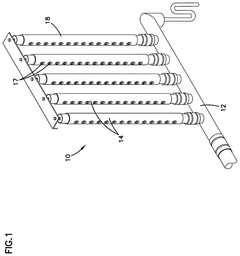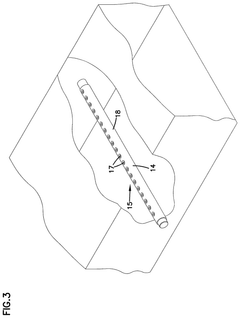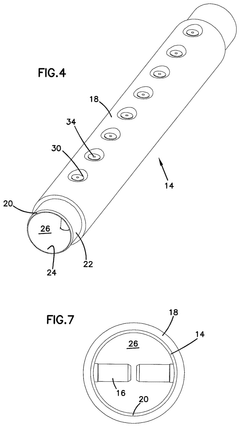How to Develop PVDF for Advanced Thermal Insulation Solutions?
PVDF Thermal Insulation Background and Objectives
Polyvinylidene fluoride (PVDF) has emerged as a promising material for advanced thermal insulation solutions, driven by the growing demand for energy-efficient buildings and industrial processes. The development of PVDF for thermal insulation applications has its roots in the broader field of polymer science and materials engineering, with a focus on enhancing the thermal properties of synthetic polymers.
The evolution of PVDF as a thermal insulation material can be traced back to the 1960s when its unique properties, such as high chemical resistance and thermal stability, were first recognized. Initially, PVDF was primarily used in chemical processing and electrical applications. However, as energy conservation became a global priority, researchers began exploring its potential for thermal insulation.
The primary objective in developing PVDF for advanced thermal insulation solutions is to create a material that combines excellent thermal resistance with other desirable properties such as durability, fire resistance, and ease of processing. This multifaceted goal requires a comprehensive understanding of PVDF's molecular structure and how it can be manipulated to enhance its insulating capabilities.
One of the key technological trends in PVDF thermal insulation development is the creation of foam structures. PVDF foams offer significantly lower thermal conductivity compared to solid PVDF, making them ideal for insulation applications. The challenge lies in developing stable, uniform foam structures while maintaining the material's other beneficial properties.
Another important aspect of PVDF thermal insulation research is the incorporation of nanoparticles or other additives to further enhance its performance. These additives can improve not only the thermal insulation properties but also mechanical strength, fire resistance, and even provide additional functionalities such as self-cleaning or energy harvesting capabilities.
The development of PVDF for thermal insulation also aligns with the broader trend of sustainable and environmentally friendly materials. While PVDF itself is not biodegradable, its long lifespan and potential for recycling make it an attractive option for long-term insulation solutions. Researchers are exploring ways to make PVDF production and processing more environmentally friendly, further enhancing its appeal as a green insulation material.
As we look to the future, the objectives for PVDF thermal insulation development are likely to focus on pushing the boundaries of its performance. This includes achieving ultra-low thermal conductivity, improving its resistance to extreme temperatures, and developing novel composite materials that combine PVDF with other high-performance materials. Additionally, there is a growing interest in smart insulation systems that can adapt to changing environmental conditions, an area where PVDF's piezoelectric properties could play a crucial role.
Market Analysis for Advanced Thermal Insulation
The market for advanced thermal insulation solutions is experiencing significant growth, driven by increasing energy efficiency requirements and sustainability concerns across various industries. PVDF (Polyvinylidene Fluoride) has emerged as a promising material for advanced thermal insulation applications due to its unique properties, including high thermal stability, chemical resistance, and excellent mechanical strength.
The global thermal insulation market is projected to reach substantial value in the coming years, with a compound annual growth rate (CAGR) outpacing many other industrial sectors. This growth is primarily fueled by stringent energy conservation regulations, rising energy costs, and the growing awareness of environmental issues. The construction industry remains the largest consumer of thermal insulation materials, followed by industrial applications and the automotive sector.
In the context of PVDF for advanced thermal insulation, the market shows particular promise in high-performance applications where traditional materials fall short. Industries such as aerospace, electronics, and oil & gas are increasingly seeking materials that can withstand extreme temperatures and harsh environments while providing superior insulation properties. PVDF's ability to maintain its performance under such conditions positions it as a high-value solution in these niche markets.
The demand for PVDF-based thermal insulation is also being driven by the rapid growth of the electric vehicle (EV) market. As EV manufacturers strive to improve battery efficiency and range, advanced thermal management systems incorporating PVDF insulation are becoming crucial. This trend is expected to create significant opportunities for PVDF producers and thermal insulation solution providers in the automotive sector.
Geographically, North America and Europe currently lead the market for advanced thermal insulation materials, including PVDF-based solutions. However, the Asia-Pacific region is expected to witness the fastest growth in the coming years, driven by rapid industrialization, urbanization, and increasing adoption of energy-efficient technologies in countries like China and India.
Despite the positive outlook, the market for PVDF in advanced thermal insulation faces challenges. The relatively high cost of PVDF compared to traditional insulation materials remains a barrier to widespread adoption, particularly in price-sensitive markets. Additionally, the development of other high-performance polymers and composite materials presents competitive pressure on PVDF-based solutions.
To capitalize on the market potential, companies developing PVDF for advanced thermal insulation should focus on enhancing the material's performance-to-cost ratio, exploring novel manufacturing techniques to reduce production costs, and developing tailored solutions for specific high-value applications. Collaborations with end-users in key industries could also accelerate the adoption of PVDF-based thermal insulation solutions and drive market growth.
PVDF Thermal Insulation: Current Status and Challenges
Polyvinylidene fluoride (PVDF) has emerged as a promising material for advanced thermal insulation solutions, yet its current status and challenges in this application require careful examination. The development of PVDF for thermal insulation has made significant strides in recent years, driven by the growing demand for high-performance, lightweight, and durable insulation materials across various industries.
Currently, PVDF-based thermal insulation solutions exhibit several advantageous properties, including excellent thermal stability, low thermal conductivity, and resistance to chemical degradation. These characteristics make PVDF an attractive option for applications in aerospace, automotive, and construction sectors, where traditional insulation materials may fall short.
One of the primary challenges in developing PVDF for advanced thermal insulation lies in optimizing its microstructure to further reduce thermal conductivity without compromising other desirable properties. Researchers are exploring various techniques, such as the incorporation of aerogels, the creation of foam structures, and the development of nanocomposites, to enhance the insulation performance of PVDF.
Another significant hurdle is the relatively high cost of PVDF compared to conventional insulation materials. This cost factor limits its widespread adoption, particularly in price-sensitive markets. Efforts are underway to develop more cost-effective production methods and to identify potential synergies with other materials to create hybrid solutions that balance performance and affordability.
The processing and manufacturing of PVDF-based insulation materials present additional challenges. Achieving consistent quality and desired properties across large-scale production runs requires precise control over processing parameters. Researchers and manufacturers are working on refining extrusion, foaming, and coating techniques to improve the scalability and reproducibility of PVDF insulation products.
Environmental concerns also pose a challenge to the development of PVDF thermal insulation. While PVDF itself is recyclable, the additives and processing aids used in its formulation may complicate end-of-life management. Developing eco-friendly formulations and establishing effective recycling processes are crucial areas of focus for ensuring the long-term sustainability of PVDF insulation solutions.
Despite these challenges, the potential of PVDF in thermal insulation continues to drive innovation. Researchers are exploring novel approaches, such as the development of PVDF nanofibers and the incorporation of phase-change materials, to push the boundaries of insulation performance. These advancements hold promise for creating next-generation thermal management solutions that can meet the increasingly demanding requirements of various industries.
Existing PVDF-based Thermal Insulation Solutions
01 PVDF composite materials for thermal insulation
PVDF can be combined with other materials to create composite structures with enhanced thermal insulation properties. These composites may include aerogels, nanoparticles, or other polymers to improve the overall insulation performance while maintaining the desirable properties of PVDF such as chemical resistance and durability.- PVDF-based thermal insulation composites: PVDF is combined with other materials to create composite thermal insulation materials. These composites often incorporate fillers or additives to enhance thermal insulation properties, mechanical strength, and durability. The resulting materials can be used in various applications, including construction, automotive, and industrial sectors.
- PVDF foam for thermal insulation: PVDF can be processed into foam structures, which significantly improve its thermal insulation capabilities. The foam structure creates air pockets that reduce heat transfer, making PVDF foam an effective insulator. This form of PVDF is particularly useful in applications requiring lightweight yet efficient thermal insulation.
- PVDF coatings for thermal insulation: PVDF can be applied as a coating to various substrates to provide thermal insulation. These coatings can be formulated to have specific thermal properties and can be used on a wide range of materials, including metals, plastics, and fabrics. PVDF coatings offer the added benefit of chemical resistance and weatherability.
- Multi-layer thermal insulation systems incorporating PVDF: PVDF is used as a component in multi-layer thermal insulation systems. These systems often combine PVDF with other materials in a layered structure to optimize thermal insulation performance. The PVDF layer can provide additional benefits such as moisture resistance and durability to the overall insulation system.
- PVDF nanofibers for advanced thermal insulation: PVDF can be processed into nanofibers, which offer enhanced thermal insulation properties due to their high surface area to volume ratio. These nanofibers can be incorporated into various materials or used to create standalone insulation products. The nanofiber structure allows for improved thermal performance while maintaining flexibility and lightweight characteristics.
02 PVDF foam structures for thermal insulation
Foamed PVDF structures can be developed to provide excellent thermal insulation. The foam structure creates air pockets within the material, significantly reducing heat transfer. Various foaming techniques and additives can be used to optimize the foam structure for specific insulation requirements.Expand Specific Solutions03 Surface modification of PVDF for improved thermal insulation
The surface of PVDF can be modified to enhance its thermal insulation properties. This may involve creating micro or nanostructures on the surface, applying coatings, or grafting other materials onto the PVDF surface. These modifications can improve the material's ability to reflect or absorb thermal radiation.Expand Specific Solutions04 PVDF-based multilayer insulation systems
Multilayer insulation systems incorporating PVDF can be designed for superior thermal insulation performance. These systems may combine PVDF with other insulating materials, reflective layers, or air gaps to create a highly effective thermal barrier suitable for various applications, including aerospace and construction.Expand Specific Solutions05 PVDF nanofiber mats for thermal insulation
PVDF nanofiber mats can be fabricated using electrospinning or other nanofiber production techniques to create highly porous and lightweight insulation materials. These nanofiber mats offer excellent thermal insulation properties due to their high surface area and low thermal conductivity, making them suitable for various applications in clothing, building materials, and industrial insulation.Expand Specific Solutions
Key Players in PVDF Thermal Insulation Industry
The development of PVDF for advanced thermal insulation solutions is in a growth phase, with increasing market demand driven by energy efficiency concerns. The global PVDF market is projected to expand significantly, reaching multi-billion dollar value in the coming years. Technologically, PVDF is maturing but still offers room for innovation. Key players like Arkema, DuPont, and Resonac Holdings are leading R&D efforts, focusing on enhancing PVDF's thermal properties and processing techniques. Academic institutions such as Anhui University and University College London are contributing to fundamental research, while companies like Zhejiang Sci-Tech University and Changzhou University are bridging the gap between academic research and industrial applications, indicating a collaborative ecosystem driving technological advancements in this field.
Arkema France SA
Zhonghao Chenguang Research Institute of Chemical Ind Co Ltd
Core Innovations in PVDF Thermal Insulation
- The use of a polyvinylidene fluoride (PVDF) fluoropolymer insulation covering on steam dispersion tubes and other system parts, which reduces condensate and heat gain, and a method for attaching this insulation using various forms and methods such as strips, tubular forms, or sprays, ensuring secure and efficient coverage.
- A method involving radical polymerization of vinylidene fluoride in aqueous dispersion using a persulfate initiator, followed by washing to reduce surfactant residues below 300 ppm, and subsequent addition of sodium acetate and potassium alkyl sulfonate to enhance thermal stability, ensuring the PVDF produced is free from undesirable surfactant residues.
Environmental Impact of PVDF Thermal Insulation
The environmental impact of PVDF thermal insulation is a critical consideration in the development and application of advanced thermal insulation solutions. PVDF, or polyvinylidene fluoride, offers excellent thermal insulation properties, but its production and use have various environmental implications that must be carefully evaluated.
The manufacturing process of PVDF involves the use of fluorine-based chemicals, which can have significant environmental consequences if not properly managed. The production of these chemicals often requires energy-intensive processes and may result in the emission of greenhouse gases. Additionally, the potential release of fluorinated compounds during manufacturing poses risks to air and water quality, necessitating stringent control measures to minimize environmental contamination.
Despite these concerns, PVDF thermal insulation can contribute positively to environmental sustainability through its energy-saving properties. By effectively reducing heat transfer, PVDF insulation helps decrease energy consumption in buildings and industrial applications, leading to lower greenhouse gas emissions associated with heating and cooling systems. This long-term energy efficiency can offset the initial environmental impact of production, especially when considering the extended lifespan of PVDF-based insulation materials.
The durability and chemical resistance of PVDF also play a role in its environmental profile. These properties contribute to a longer service life for insulation materials, reducing the frequency of replacement and associated waste generation. However, the end-of-life management of PVDF insulation presents challenges due to its resistance to degradation. Proper recycling and disposal methods must be developed to prevent PVDF from accumulating in landfills or natural environments.
Recent advancements in PVDF production techniques have focused on reducing environmental impact. These include the development of water-based PVDF formulations that minimize the use of organic solvents, as well as improved manufacturing processes that reduce energy consumption and emissions. Furthermore, research into bio-based alternatives and the incorporation of recycled content in PVDF production shows promise in decreasing the material's overall environmental footprint.
The application of PVDF thermal insulation in renewable energy technologies, such as solar panels and energy storage systems, further enhances its environmental benefits. By improving the efficiency and longevity of these clean energy solutions, PVDF contributes to the broader transition towards sustainable energy sources.
As environmental regulations become more stringent, the development of PVDF for advanced thermal insulation solutions must prioritize eco-friendly production methods and end-of-life strategies. This includes exploring closed-loop recycling systems, enhancing the biodegradability of PVDF-based materials, and optimizing the balance between thermal performance and environmental impact. By addressing these challenges, the thermal insulation industry can harness the benefits of PVDF while minimizing its ecological footprint.
Cost-Benefit Analysis of PVDF Thermal Insulation
The cost-benefit analysis of PVDF thermal insulation reveals a compelling case for its adoption in advanced thermal insulation solutions. PVDF, or polyvinylidene fluoride, offers exceptional thermal insulation properties that can significantly reduce energy consumption in various applications. The initial investment in PVDF-based insulation materials may be higher compared to traditional alternatives, but the long-term benefits often outweigh the upfront costs.
One of the primary advantages of PVDF thermal insulation is its durability and longevity. The material's resistance to chemical degradation, UV radiation, and extreme temperatures ensures a longer lifespan compared to conventional insulation materials. This extended service life translates to reduced replacement and maintenance costs over time, contributing to a favorable return on investment.
Energy savings represent a substantial benefit of PVDF thermal insulation. Its superior insulating properties lead to decreased heat transfer, resulting in lower heating and cooling costs for buildings and industrial processes. In regions with extreme climates or in industries with high energy demands, the potential for cost savings is particularly significant. Studies have shown that PVDF-based insulation can reduce energy consumption by up to 30% compared to traditional materials.
The environmental impact of PVDF thermal insulation should also be considered in the cost-benefit analysis. While the production of PVDF may have a higher carbon footprint initially, the energy savings over its lifetime can offset this impact. Additionally, the material's recyclability and potential for reuse in other applications contribute to its overall sustainability profile.
In industrial settings, PVDF thermal insulation can lead to improved process efficiency and reduced operational costs. By maintaining stable temperatures in critical equipment and pipelines, PVDF insulation minimizes heat loss and helps optimize energy usage. This can result in substantial cost savings for industries such as oil and gas, chemical processing, and food production.
The fire-resistant properties of PVDF thermal insulation provide an added layer of safety, potentially reducing insurance costs and mitigating the risk of fire-related damages. This aspect is particularly valuable in high-risk environments where fire safety is a critical concern.
While the initial cost of PVDF thermal insulation may be a barrier for some applications, government incentives and rebates for energy-efficient solutions can help offset these expenses. As energy regulations become more stringent, the adoption of high-performance insulation materials like PVDF is likely to become more economically attractive.
In conclusion, the cost-benefit analysis of PVDF thermal insulation demonstrates its potential for long-term economic and environmental advantages. The combination of energy savings, durability, and enhanced safety features positions PVDF as a promising material for advanced thermal insulation solutions across various sectors.







